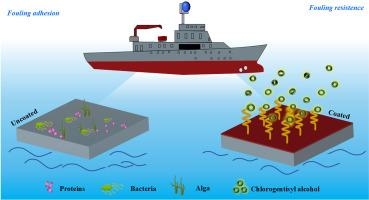基于改性聚氨酯和埃洛韦石纳米管的氯丁醇缓释船用防污涂料
IF 5.8
2区 地球科学
Q2 CHEMISTRY, PHYSICAL
引用次数: 0
摘要
海洋生物污染问题严重制约着航运业的可持续发展。针对这一技术挑战,本研究创新性地开发了一种基于双防污机制协同效应的复合涂层体系(HFSiPU)。该系统首先采用分子包封技术将合成的氯原醇(CHBA)装入高岭土纳米管(HNT)中,构建了具有控释防污剂静态防污功能的纳米颗粒(CHBA@HNT)。HNT独特的管状结构使材料具有高达15 wt%的极好的CHBA装载能力。同时,通过有机氟硅的协同改性策略制备的疏水聚氨酯(FSiPU)基体,通过其动态表面特性实现了长效防污。实验结果表明,CHBA@HNT在复合涂层体系中的日释放速率稳定在6.0 μg/cm2以上31天。改性后的FSiPU具有显著增强的疏水性,与传统聚氨酯相比,其水接触角增加了115°(增加了42%),表面自由能降低到18 mJ/m2(减少了63%)。在防污性能评价中,HFSiPU涂层对典型的大肠杆菌、金黄色葡萄球菌以及海洋细菌和藻类均表现出良好的抑制效果,对所有被测生物的生物膜粘附抑制率均保持在90%以上。本研究通过将静态控释和动态表面防污机制有效结合,为新一代智能船舶防护材料的开发提供了创新的见解和技术途径。本文章由计算机程序翻译,如有差异,请以英文原文为准。

Marine antifouling coating based on modified polyurethane and halloweite nanotubes for slow-release of chlorgentianol alcohol
The problem of marine biological pollution seriously restricts the sustainable development of the shipping industry. In response to this technical challenge, this study innovatively developed a composite coating system (HFSiPU) based on the synergistic effect of the dual antifouling mechanism. The system first used molecular encapsulation technology to load the synthesized chlorgentianol alcohol (CHBA) into halloysite nanotubes (HNT), constructing nanoparticles (CHBA@HNT) with a static antifouling function enabled by controlled-release antifoulant. The unique tubular structure of HNT endows the material with an excellent CHBA loading capacity of up to 15 wt%. Meanwhile, a hydrophobic polyurethane (FSiPU) matrix, prepared through the synergistic modification strategy of organofluorosilicon, achieved long-term antifouling through its dynamic surface properties. Experimental results revealed that the daily release rate of CHBA@HNT in the composite coating system remained stable at 6.0 μg/cm2 for more than 31 days. The modified FSiPU exhibited significantly enhanced hydrophobicity, with a water contact angle of 115° (a 42% increase) and a reduced surface free energy to 18 mJ/m2 (a 63% decrease) compared to conventional polyurethane. In antifouling performance evaluations, the HFSiPU coating demonstrated excellent inhibitory effects against typical Escherichia coli, Staphylococcus aureus, as well as marine bacteria and algae, with biofilm adhesion inhibition rates remaining above 90% for all tested organisms. This research provides innovative insight and technical pathways for the development of a new generation of intelligent ship protection materials by effectively integrating static controlled-release and dynamic surface antifouling mechanisms.
求助全文
通过发布文献求助,成功后即可免费获取论文全文。
去求助
来源期刊

Applied Clay Science
地学-矿物学
CiteScore
10.30
自引率
10.70%
发文量
289
审稿时长
39 days
期刊介绍:
Applied Clay Science aims to be an international journal attracting high quality scientific papers on clays and clay minerals, including research papers, reviews, and technical notes. The journal covers typical subjects of Fundamental and Applied Clay Science such as:
• Synthesis and purification
• Structural, crystallographic and mineralogical properties of clays and clay minerals
• Thermal properties of clays and clay minerals
• Physico-chemical properties including i) surface and interface properties; ii) thermodynamic properties; iii) mechanical properties
• Interaction with water, with polar and apolar molecules
• Colloidal properties and rheology
• Adsorption, Intercalation, Ionic exchange
• Genesis and deposits of clay minerals
• Geology and geochemistry of clays
• Modification of clays and clay minerals properties by thermal and physical treatments
• Modification by chemical treatments with organic and inorganic molecules(organoclays, pillared clays)
• Modification by biological microorganisms. etc...
 求助内容:
求助内容: 应助结果提醒方式:
应助结果提醒方式:


